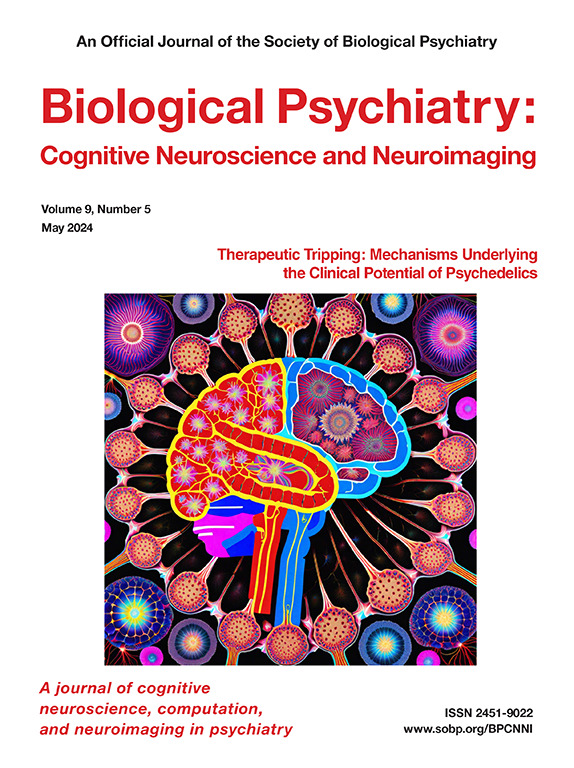探索功能磁共振成像(fMRI)大麻线索-反应范式在寻求治疗的成人大麻使用障碍患者中的实用性。
IF 4.8
2区 医学
Q1 NEUROSCIENCES
Biological Psychiatry-Cognitive Neuroscience and Neuroimaging
Pub Date : 2025-05-01
DOI:10.1016/j.bpsc.2024.09.006
引用次数: 0
摘要
背景:研究大麻使用障碍(CUD)线索反应的功能磁共振成像(fMRI)研究要么样本量较小,要么涉及非寻求治疗的参与者。作为辅助分析,我们对参加两项独立临床试验(伐伦克林或重复经颅磁刺激-rTMS)的 CUD 参与者实施了一项 fMRI 提示反应任务,以确定寻求治疗的 CUD 参与者的任务激活模式。我们的目标是确定所有样本的激活模式,并确定行为相关性。此外,我们还对各项研究进行了比较,以确定模式是否一致:方法:患有中度或重度 CUD 的寻求治疗者在基线时通过大麻渴求问卷简表(MCQ-SF)测量其行为渴求,并在禁用大麻 24 小时后在 fMRI 期间完成视觉大麻线索反应任务(测量血氧vel依赖性-BOLD 反应):结果:65 名参与者(37 人使用伐尼克兰,28 人使用经颅磁刺激;32% 为女性;平均年龄(30.4±9.9SD)。当对比大麻图像与匹配的中性图像时,参与者在双侧腹内侧前额叶、背外侧前额叶、扣带回前部和视觉皮层以及纹状体中显示出更大的BOLD反应。内侧前额叶皮层与杏仁核和视觉皮层之间有更强的基于任务的功能连接(tbFC)。在全部样本中,渴求与左侧腹侧纹状体的BOLD反应呈负相关(R2=-0.32;P=0.01)。不同研究之间的激活或tbFC均无明显差异:讨论:在两个不同的寻求治疗的 CUD 群体中,与执行功能和奖赏处理相关的区域的大麻线索反应和 tbFC 均有所增加。大麻渴求与左侧腹侧纹状体的线索反应呈负相关。本文章由计算机程序翻译,如有差异,请以英文原文为准。
Exploring the Utility of a Functional Magnetic Resonance Imaging Cannabis Cue-Reactivity Paradigm in Treatment-Seeking Adults With Cannabis Use Disorder
Background
Functional magnetic resonance imaging studies examining cue reactivity in cannabis use disorder (CUD) either have had small sample sizes or have involved non–treatment-seeking participants. As a secondary analysis, we administered a functional magnetic resonance imaging cue-reactivity task to participants with CUD enrolled in 2 separate clinical trials (varenicline or repetitive transcranial magnetic stimulation) to determine the task activation patterns for treatment-seeking participants with CUD. We aimed to determine the activation patterns for the total sample and behavioral correlates. We additionally compared studies to determine if patterns were consistent.
Methods
Treatment-seeking participants with moderate or severe CUD had behavioral craving measured at baseline using the Marijuana Craving Questionnaire–Short Form and completed a visual cannabis cue-reactivity task during functional magnetic resonance imaging (measuring the blood oxygen level–dependent response) following 24 hours of cannabis abstinence.
Results
The sample included 65 participants (n = 37: varenicline trial; n = 28: repetitive transcranial magnetic stimulation trial; 32% female; mean age = 30.4 ± 9.9 years). When comparing cannabis images versus matched neutral images, participants showed greater blood oxygen level–dependent response in bilateral ventromedial-prefrontal, dorsolateral-prefrontal, anterior cingulate, and visual cortices as well as the striatum. There was stronger task-based functional connectivity between the medial prefrontal cortex and both the amygdala and the visual cortex. Craving negatively correlated with blood oxygen level–dependent response in the left ventral striatum (R2 = −0.32; p = .01) in the full sample. There were no significant differences in either activation or task-based functional connectivity between studies.
Conclusions
In 2 separate treatment-seeking groups with CUD, there was increased cannabis cue reactivity and task-based functional connectivity in regions related to executive function and reward processing. Cannabis craving was negatively associated with cue reactivity in the left ventral striatum.
求助全文
通过发布文献求助,成功后即可免费获取论文全文。
去求助
来源期刊

Biological Psychiatry-Cognitive Neuroscience and Neuroimaging
Neuroscience-Biological Psychiatry
CiteScore
10.40
自引率
1.70%
发文量
247
审稿时长
30 days
期刊介绍:
Biological Psychiatry: Cognitive Neuroscience and Neuroimaging is an official journal of the Society for Biological Psychiatry, whose purpose is to promote excellence in scientific research and education in fields that investigate the nature, causes, mechanisms, and treatments of disorders of thought, emotion, or behavior. In accord with this mission, this peer-reviewed, rapid-publication, international journal focuses on studies using the tools and constructs of cognitive neuroscience, including the full range of non-invasive neuroimaging and human extra- and intracranial physiological recording methodologies. It publishes both basic and clinical studies, including those that incorporate genetic data, pharmacological challenges, and computational modeling approaches. The journal publishes novel results of original research which represent an important new lead or significant impact on the field. Reviews and commentaries that focus on topics of current research and interest are also encouraged.
 求助内容:
求助内容: 应助结果提醒方式:
应助结果提醒方式:


